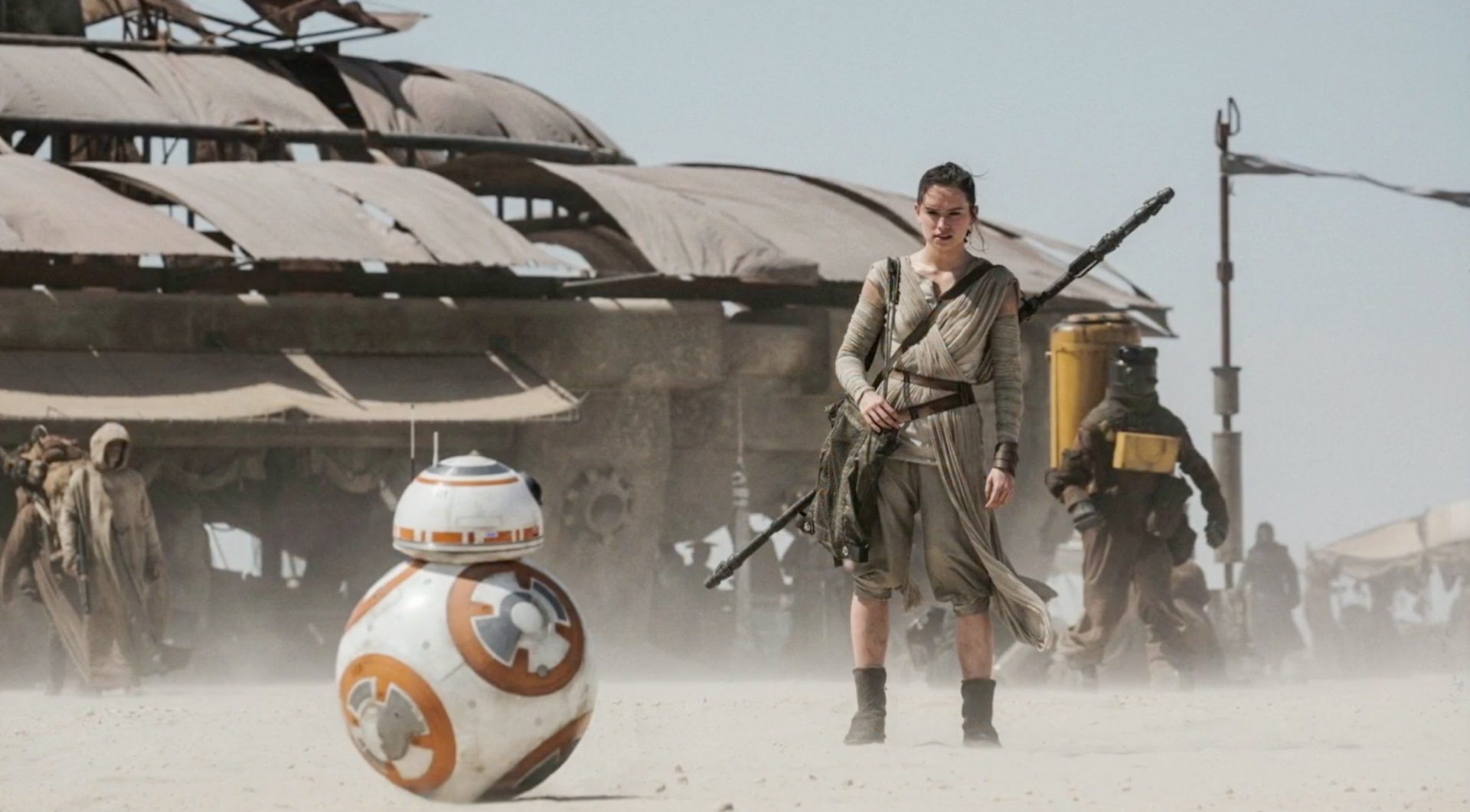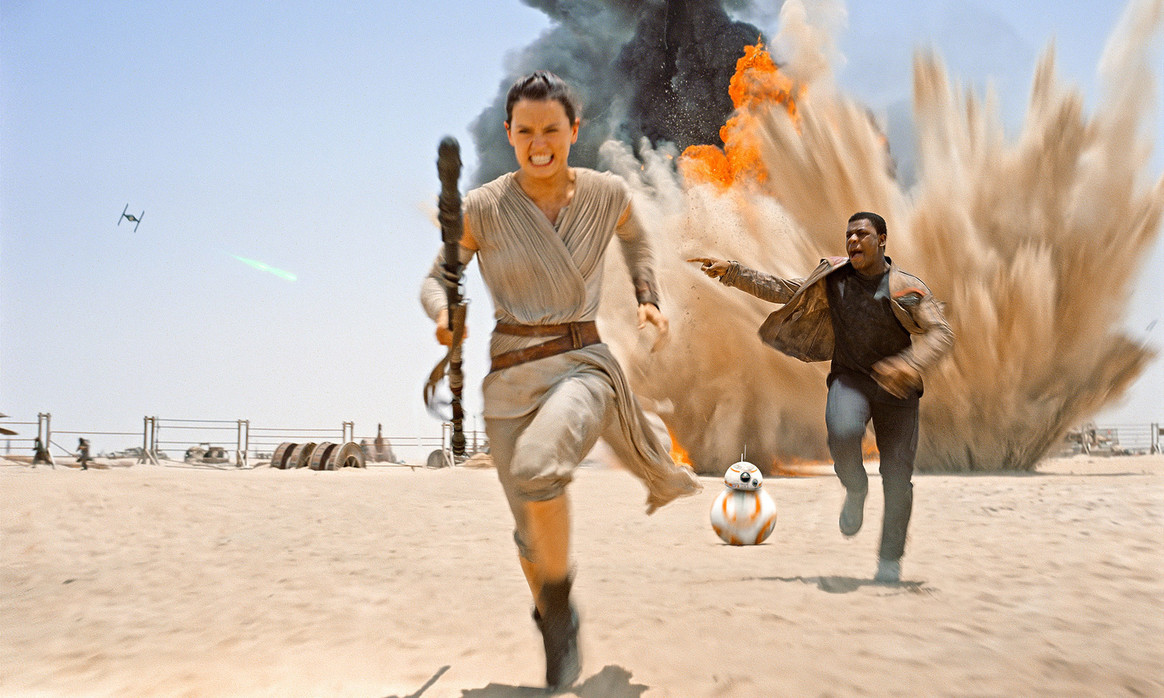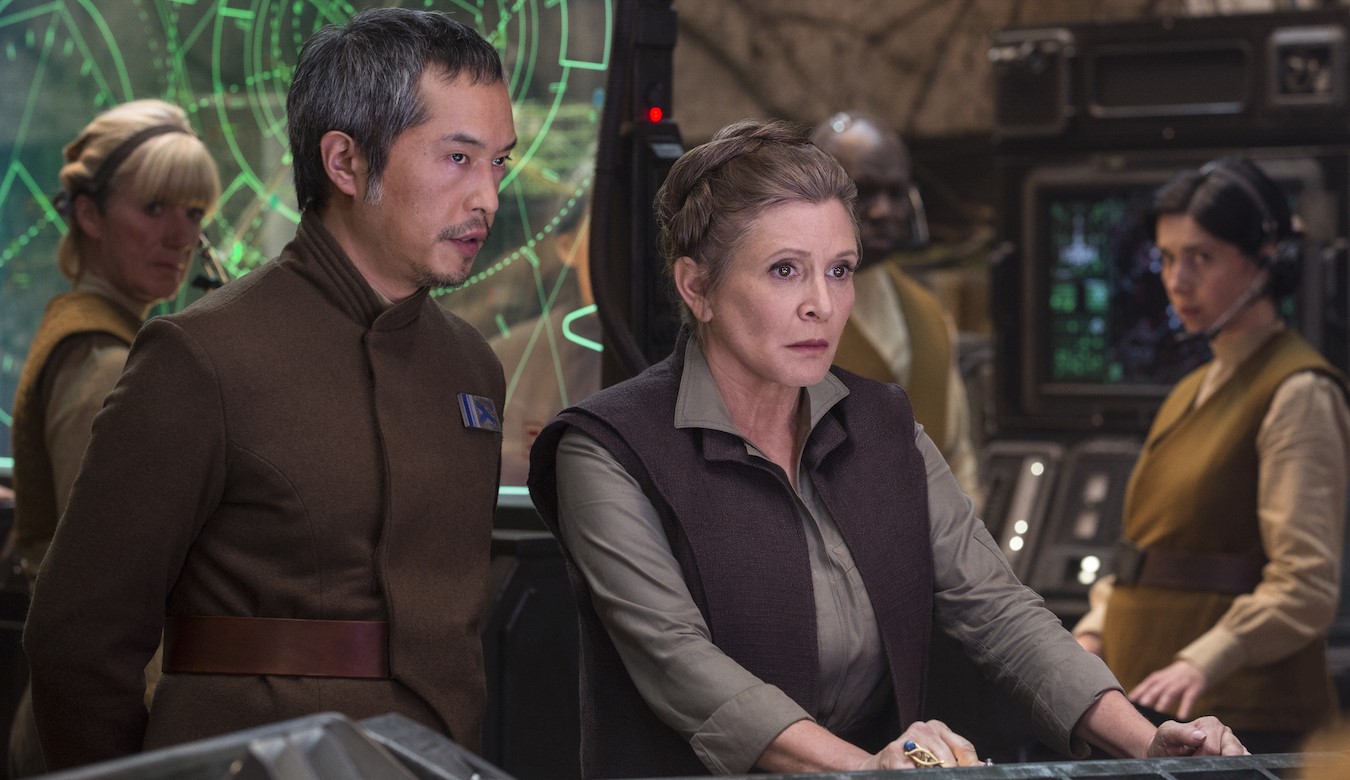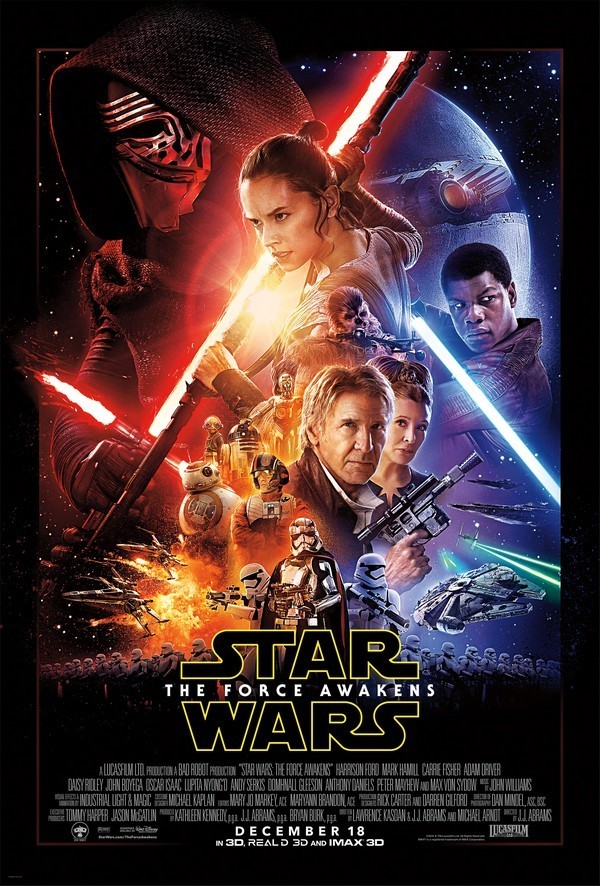USA. 2015.
Crew
Director – J.J. Abrams, Screenplay – J.J. Abrams, Michael Arndt & Lawrence Kasdan, Producers – J.J. Abrams, Bryan Burk & Kathleen Kennedy, Photography (3D) – Dan Mindel, Music – John Williams, Visual Effects Supervisor – Roger Guyett, Visual Effects – Industrial Light and Magic (Supervisors – Ben Morris & Patrick Tubach, Animation Supervisor – Paul Kavanaugh) & Levin Optical (Supervisor – Luke McDonald), Creature Effects Supervisor – Neal Scanlan, Special Effects Supervisor – Chris Corbould, Production Design – Rick Carter & Darren Gilfod. Production Company – Lucasfilm Ltd/Bad Robot.
Cast
Daisy Ridley (Rey), John Boyega (Finn/FN-2187), Harrison Ford (Han Solo), Adam Driver (Kylo Ren), Oscar Isaac (Poe Dameron), Carrie Fisher (General Leia Organa), Peter Mayhew (Chewbacca), Lupita Nyong’o (Maz Kanata), Andy Serkis (Supreme Leader Snoke), Domhnall Gleeson (General Hux), Anthony Daniels (C3PO), Gwendoline Christie (Captain Phasma), Simon Pegg (Unkar Plutt), Max Von Sydow (Lor San Tekka), Mark Hamill (Luke Skywalker)
Plot
It is many years after the fall of The Empire. The First Order has arisen seeking to rebuild the Empire. They are now focusing their efforts on trying to eliminate the last Jedi, Luke Skywalker. However, Luke has gone into hiding. On the desert planet Jakku, the resistance pilot Poe Dameron obtains a chip with a map to Luke’s whereabouts and hides it inside a BB8 droid just before he is captured. The BB8 falls into the hands of Rey, a young orphan who lives as a scavenger. Meanwhile, Poe is freed by the stormtrooper FN-2187 who has decided to desert, shocked at being required to slaughter innocents. With Poe seemingly killed in a crash on the surface of Jakku, FN-2187, nicknamed Finn by Poe, joins Rey, pretending to be a member of the resistance. They flee aboard a ship as the stormtroopers come searching for them. They are located by none other than Han Solo and realise that the ship is The Millennium Falcon. Pursued by The First Order, they head to the planet Takodana and into the hands of the resistance where Rey starts to understand her ability to control The Force. Meanwhile, Han reunites with Leia as the rebels are faced with the threat of the First Order’s new planetary super-destroyer, The Starkiller Base.
I have said before, I would not be writing this site today if it weren’t for the original Star Wars (1977). It was the first film I saw in a theatre and it started the flames of my young imagination. I lived and breathed nothing but Star Wars for the next few years. In buying up all the issues of the magazines of the new science-fiction boom like Starlog, Starburst and Fantastic Films, among others, and obsessively pouring over them, the need to capture and detail the experience formed an essential part of one’s brain as it grew into adolescence.
I was there on opening weekends of every phase of the Star Wars saga, old modern and new. There was the excitement of watching The Empire Strikes Back (1980) for the first time and I was old enough to feel the disappointment of the first trilogy’s wrap-up in Return of the Jedi (1983). My now teen brain clamoured for enough of that original jolt to sit through watchings of The Star Wars Holiday Special (1978) and the cinematic releases of The Ewok Adventure/Caravan of Courage (1984) and Ewoks and the Marauders of Endor (1986) in the hope of still getting some more of that fix. Alas, that would be it for the next decade or more.
The year that Star War Episode I: The Phantom Menace (1999) came out was also the year that I first put Moria online and Phantom Menace was among one of the first pages to go up. From that opening shot where the introductory title card tracks off into infinity and the moment the Star Destroyer rumbles over the screen in Star Wars, my young mind had become a sponge that had soaked up an immense amount of trivia. All the reading of the magazines and books had led me in myriad different directions – Star Wars had led me to explore the works that had informed it such as Flash Gordon (1936) and E.E. ‘Doc’ Smith, to search out The Hidden Fortress (1958) and then discover Akira Kurosawa; George Lucas had led me to THX 1138 (1971) and American Graffiti (1973) and then to Francis Ford Coppola; Peter Cushing and Dave Prowse led the way to Hammer Films; and that’s to say nothing of the countless other works following in the wake of Star Wars and what they opened the way to. Thus when the prequel trilogy – The Phantom Menace, Star Wars Episode II: Attack of the Clones (2002) and Star Wars Episode III: Revenge of the Sith (2005) – came out, it was greeted not by naive enthusiasm but by a full formed cineaste that had been shaped by exposure to the original.

I certainly was not alone in being one of the people that Star Wars touched. In fact, there seemed to be so many fans that Lucasfilm spent over a decade trying to generate money off of them. Even aside from the mechandisibles spun off from the original trilogy, Lucasfilm put out endless series of sequel adventures, books devoted to even minor background characters, warehouses of toys, books of artwork, soundtracks to books, computer games and just about every form of merchandising that could be conceived. By the time the prequel trilogy arrived, fans of the original were less those who had discovered and been enthused by something than they were an identifiable marketing niche. What did not help the studio any was the universal disappointment of the prequels – George Lucas’s mishandling of the characters, the CGI overkill and crimes against humanity such as Jar-Jar Binks. There was even an entire documentary The People vs. George Lucas (2011) devoted to the fan reaction. By the end of this, George Lucas felt less like someone with an uncanny figure on the pulse of his generation than someone who had stumbled onto a hit and spent the rest of their career milking it.
It seemed an act of resignation on George Lucas’s part when he sold the rights to Star Wars to Disney in 2012. It was a surrender by someone who failed to understand why he had missed the boat second time around, of someone who had become so surrounded by his own empire in seclusion on Skywalker Ranch that he was out of touch with the people on the end user side of it. The sale seemed made by someone getting old (Lucas hits 71 this year) who didn’t want the weight of what he had created heaped back on shoulders again – only for Lucas to then suffer the indignity of Disney deciding they didn’t want his involvement on the new films. Disney proceeded to hype their new Star Wars series into a massive campaign that includes releasing a sequel every second year, alongside original works set in the Star Wars universe every other year – up next was Rogue One (2016) set just prior to the events of the original, followed by Solo: A Star Wars Story (2018), plus the tv series’ The Mandalorian (2019- ), The Book of Boba Fett (2021-2), Andor (2022- ), Obi-wan Kenobi (2022), Ahsoka (2023- ) and The Acolyte (2024). Directly following on from this was Star Wars Episode VIII: The Last Jedi (2017) and Star Wars Episode IX: Rise of the Skywalker (2019).
Another person inspired by the original Star Wars was J.J. Abrams. Abrams became a bright young, rising name with scripts for films such as Regarding Henry (1991), Forever Young (1992) and Joy Ride (2001), before creating/producing the tv series Felicity (1998-2002). The Abrams cult grew with his next two tv series – the smart and stylish spy series Alias (2001-6) and the massively successful hit of the cryptic desert island drama Lost (2004-10), as well the paranormal/fringe science investigator series Fringe (2008-13). Abrams made his feature film directorial debut with Mission: Impossible III (2006) at the personal behest of Tom Cruise. Abrams then went onto direct the big screen revival of Star Trek (2009) and its sequel Star Trek: Into Darkness (2013), as well as the Coming of Age film Super 8 (2011). Abrams has also produced other genre tv series like Person of Interest (2011-6), Alcatraz (2012), Revolution (2012-4), Almost Human (2013-4), 11.22.63 (2016), Westworld (2016-22), Castle Rock (2018-19), Lovecraft Country (2020) and Lisey’s Story (2021). He has also produced the films Cloverfield (2008), Mission: Impossible – Ghost Protocol (2011), Mission: Impossible – Rogue Nation (2015), Star Trek: Beyond (2016), 10 Cloverfield Lane (2016), The Cloverfield Paradox (2018), Mission: Impossible – Fallout (2018) and Overlord (2018).

So turning to Star Wars Episode VII: The Force Awakens, how does it stack up?
What It Does Well
It Trims Back the CGI Excesses of the Prequels
One of the things that everybody hated when George Lucas re-released the original trilogy in 1997 was that he had digitally upgraded many of the scenes– adding different types of explosions of the Death Star, more detail to the Sandcrawler and the background of Mos Eisley plus the dreaded ‘Greedo Shot First’ scene, among others – and often mangling the nature of the scenes. By the time of the prequels, Lucas was showing off the mastery of the CGI environment but when it came to films like Attack of the Clones, you often felt that the CGI had completely overwhelmed a scene – where the intent to have so much happening all at once resulted in effects overload at the expense of dramatic engagement. The sequels increasingly feel like pretty and dazzling wonderment that has all the substance of eye candy and crucially none of the sense of wonder that scenes in the originals like the attack on the Death Star or the fight with the Walkers held.
By contrast, J.J. Abrams has made the effort to trim back on the CGI and rely more on physical effects the way the original series, which notedly came out before the advent of the CGI revolution, did. I am not entirely sure to what extent that is the case – after all, the original Star Wars films were not purely physical effects films and were in fact at the vanguard of visual effects technology in the era – but it makes for a great selling point for this film. And it shows on screen – The Force Awakens is cleaner, its’ action much more engaging, the backgrounds of shots something that you can appreciate rather than feeling so overwhelmed because everything takes place at a subliminal blur or that things are there just so new entire lines of toys can be sold.
New Characters
The Force Awakens introduces two new principals and a host of new supporting characters. It is an object lesson in how to create characters with engaging sympathies and identifiable arcs in a way that Star Wars got right and the prequels missed by several hundred parsecs. The prequels gave us heroes and anti-heroes but what killed them were bad performances and George Lucas’s seeming inability to write decent dialogue or be attuned to the way directors should let actors develop character.

By contrast, J.J. Abrams is much more on the ball. The two leads have the same youthful enthusiasm that the young Mark Hamill embodied. Meanwhile, Adam Driver’s Kylo Ren, while only a supporting character, gets right in a few key scenes the conflicted ambiguity that Lucas intended Anakin Skywalker to have but took an entire trilogy to drag out to a foregone conclusion. Not to mention that BB8 has an adorable puppy-dog innocence, the sort that made R2D2 and C3P0 two of the most endearing characters in the original trilogy (and was completely lost in the prequels).
What It Gets Wrong
Fanservice
I debated whether this was a positive point or a negative point. After all, the entire selling point of the film is in bringing together the leads from the original once again – the much touted “We’re home, Chewie” line from the trailer got a cheer when it first appeared in theatres. On the other hand, nearly half of the film here feels like it has been set up to deliver some aspect that homages the original film(s). Plot often feels like it detours so that we can see the derelict hulks of Star Cruisers in the desert, where the nearest convenient ship for Rey and Finn to escape aboard just happens to be the Millennium Falcon, where Finn sits down aboard the Falcon and just happens to activate the old 3D chessgame, where Han gets a throwaway line about the Millennium Falcon having made the Kessel Run in under twelve parsecs, where there is momentous build up to the rediscovery of Luke’s lightsabre and Darth Vader’s crushed mask; or where we get cameos from various of the alien commanders from the rebel fleet in Return of the Jedi and so on. This is a film after all where the climax of the film is the build-up to the reintroduction of one of the original characters. All of these seem little bits there to trigger one’s memories of the things that were great about the original but at times it comes close to feeling like that is the whole of the film.
The Plot Slavishly Follows Star Wars
Let us count the parallels between the two films – droid containing information vital to the resistance falls into the hands of a young kid on a desert planet; kid makes an escape with stormtroopers and an evil dark lord hot on their trail; kid falls in with a cocky space pilot who takes them on a journey into a dingy space bar filled with a motley crew of aliens; kid comes to discover their own abilities as a Jedi, while also inheriting a lightsabre; the evil dark lord is outfitted in black and hides their face behind a metal mask while demonstrating a fondness for strangling failed subordinates; the dark lord bows to a supreme leader who appears as a hologram; the girl is taken prisoner and tortured for information by the dark lord as the young guy sets out on a reckless mission to rescue her; the evil empire is readying a new planet-size weapon that can obliterate entire worlds; the only hope is for the rebels to fly in in small one-person fighters and blow it up by firing into an exhaust port (and from Return of the Jedi, the success of the rebel’s plans being dependent on a ground assault shutting off the forcefield at the same time as the rebel fleet flies in to attack).
Part of the problem here, I think, is simply that Star Wars circles around a few too many familiar tropes without variation. The films are adventure stories that consist of not too more than lots of running about, things blowing up and the requisite lightsabre duel in every film. On the other hand, what we rarely get are explorations of the characters and the world they live in. The complexities that the Star Wars universe exists in live in very black-and-white divides. I might do the heretical and compare Star Wars to Star Trek – whatever else you want to say for and against either, the Star Trek universe does a much more in-depth and adult job of showing us the lives of the regular characters and engaging in the cultures and politics of the worlds visited, which gives it a wealth of story possibilities that have not been exhausted, whereas the Star Wars universe merely contents itself with offering up new effects sequences.

In All This Stinking Galaxy, I Had to Run Into You
Space is big, really big in ways that our human minds can’t even grasp. The Star Wars universe sees it filled with myriad habitable planets and an entire United Nations of different species all rubbing shoulders. Despite the vastness, it is regularly filled with whopping coincidences wherein people keep running into those they know as though the entire galaxy were little more than a small town. Take the original trilogy – out of the millions, probably billions, that live on just one planet, a droid falls into the hands of a young farmboy who leads him to his father’s mentor and the discovery of his own abilities, only for him to learn in successive chapters that the person who sent the droid was none other than his own sister and that the person ruthlessly pursuing him is his own father.
There is a similar kind of improbable coincidence in play here – droid falls into the hands of a girl who is led on a journey where she just happens to discover the Millennium Falcon, which leads them to Han Solo. Equally, they go to get help on the planet Takodana where she just happens to wander into the basement and opens an old chest to discover none other than Luke Skywalker’s lightsabre, which triggers a series of flashbacks that reveal she is related to the action in some way, while we also discover that the person ruthlessly pursuing them is none other than the son of the leads. This is the sort of improbable plotting twists you usually get in soap operas and it cannot help but seem ever so faintly ridiculous when it is spread onto a massively peopled galactic stage where no matter where characters go they are constantly running into some familial connection.
In the End
The Force Awakens didn’t disappoint me. Mindedly, the prequels had left me with lowered expectations of the Star Wars series so they weren’t that high going in. What I expected was a nostalgia film and as such The Force Awakens holds up in all the areas you imagined it would with Harrison Ford doing most successfully, slipping back into the role of Han as though not a day had passed. (Carrie Fisher on the other hand seems a lot more subdued – I kept wondering where the feisty pepperiness of Princess Leia had gone to). J.J. Abrams has kept in check the empty flash and action that had marked his Star Trek films – in fact, effects and action sequence-wise, this is probably the quietest of all the Star Wars films.
On the other hand, we have characters with big arcs driving the story and in such a way that we actually want to see where things lead (something that singularly failed to happen when you reached the end of The Phantom Menace). All of the weaker aspects are excused by a strong final act and a left field tragic death that more than makes up for most of the other issues. It’s not another Empire Strikes Back but it is certainly better than all of the prequels.
Trailer here:-


